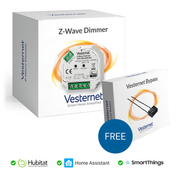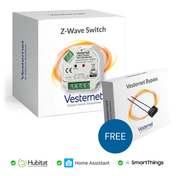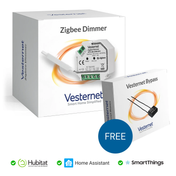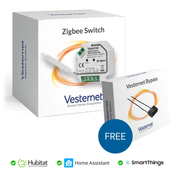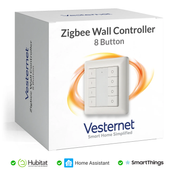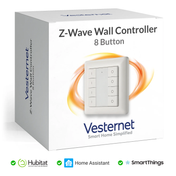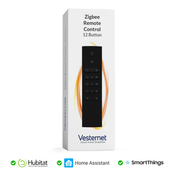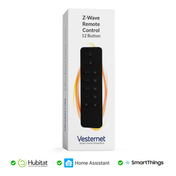What is Home Automation?
The simple answer is - anything you want it to be!
Home Automation enables you to use your home's Lighting, Heating and home appliances (such as washing machines, dishwashers and tumble driers) more conveniently and efficiently. And, at the same time giving you greater levels of comfort and security.

It can be as simple as remote or automatic control of a few lights, or it can be a complete system that controls all major parts of your home.
Smart Home Technology is anything that gives you automatic control of things around the home, turning it from "dumb" to smart.
Why Do You Want A Smart Home?
Perhaps you're concerned about your energy bills and would like to reduce your carbon footprint? With a Home Automation system in place you can create detailed analysis of the areas in your home that are costing you money.
Not interested in graphs and figures? Simply set the system to manage your energy use in the most efficient way - turn lights off when rooms are unoccupied, reduce the heating temperature when nobody's home and turn appliances off at the socket to minimise "standby" power drains.
Maybe convenience and comfort are your primary goals, so your focus could be on your family wellbeing - your Smart Home can monitor the air quality and open or close windows as required, or control your HVAC system to ensure your house has a constant supply of fresh and filtered air.
With the stresses of modern life nowadays, we're all likely to benefit from some form of assisted living and there's nothing quite like having your own personal assistant at your beck and call! Whether you're an Alexa fan, a Siri convert or an OK Google addict, a Voice Assistant can be used to interact with your Smart Home like never before.
From controlling your lights, adjusting your room temperature, answering your phone calls, checking who's at the front door or triggering entire sequences of events from a single word, Voice control is no longer confined to the movies - now we can all be like Tony Stark and chat with our own version of Jarvis!
Understanding The Benefits Of Home Automation
It might not be immediately obvious but a Smart Home can cover many areas and scenarios throughout your house.

Lighting
Different rooms have different lighting needs, but you might also need varying levels or types of light depending on what you're doing at the time. Low level lighting in the living room is great for listening to music and reactive lighting (where the lighting changes in sync with moving images) is great for watching movies, but you'll probably want the room more brightly and consistently lit if you're reading a book or sewing.
Home Automation empowers you and your family to take control of your lighting, adjusting and tweaking it to suit your needs at different times of the day .... all automatically without you needing to lift a finger!
Heating
Smart Home Heating allows you to change the heating in an entire room from a single button press, automatically based on the time of day or when you start an activity such as cooking, exercising or watching a movie snuggled with your family on the sofa on a cold winter evening.
Heating your home is likely something that you take for granted so you just leave it alone doing its thing. Whether you're using gas, oil or some other source, if you compare your energy bills over the last few years though and we bet you'll see some significant rises. A Home Automation system can allow you to monitor your energy use, minimise it and reign in those costs, saving you money.
Security
Smart Home Security means that your home can be protected against intrusion, burglaries, break-ins, property damage and trespassing, just like a standard alarm or security system does. If the Home Automation system detects any of these it can raise the alarm by sounding sirens, sending text messages and email alerts and even flashing your lights to attract attention.
You can have lights operate automatically at night or when you're away from home to increase the security of your house. Light up those dark areas if motion is detected and if you're away on holiday, you can have the lights turn on and off at irregular intervals, making it look like your house is still occupied.
Energy Efficiency
There are two reasons why we as consumers want to save energy - the obvious one is to reduce our bills and the other is to help reduce greenhouse gasses and pollution and to save our planet.
If we're being totally honest though, the vast majority of people won't spend money to make changes unless it's going to save us money in the long term!
Home Automation (by definition) can automate saving energy for you. It can monitor where and how you use energy, helping you identify how you can make savings. You can then set your Smart Home to control these areas and leave it to run. It really does look after itself, things just happen - silently saving you money.
Emergency
A Smart Home system can bring piece of mind to you and your familiy, constantly monitoring and on the lookout for potential emergency situations, ready to act as soon as something out of the ordinary occurs.
Flooding, water leaks, fire, smoke, carbon-monoxide and even things like air quality - all can be under real-time surveillance by the Home Automation system allowing it to give an early warning before disaster strikes.
Comfort
Home Automation brings comfort and convenience to all areas of your home. Along with lighting, heating and appliances, motorised systems such as blinds, curtains, awnings, sun shades, shutters or even gates and garage doors can be controlled automatically or remotely.
Letting your Smart Home look after you and your family means you can focus on what really matters in your everyday life.
Where To Begin Automating Your Home?
Regardless of which technology you use in your Home Automation system, the basic building blocks and components will be similar. Most systems will have a central controller, sensors that tell you what is happening (motion, doors opening, temperature, humidity, light, etc) and actuators that make things happen (turning on a light, switching off the TV, opening the blinds, etc).

The purpose of this guide is to help you understand what the components do and how they work together.
There are a wide range of Home Automation technologies to choose from and this can be confusing to people new to the area. Fortunately, this is less of a minefield than it used to be as many systems now work with each other, even if the underlying technologies are different. This means that you don't need to know all the inner workings of particular products - you're able to choose the ones that suit you best.
Tips For Getting Started With Your Smart Home System
There are broadly two types of Home Automation systems.
The main systems use "standard" wireless technologies such as Z-Wave, Zigbee & WiFi and the advantage of these is that they can use products from different vendors and often work together directly.
The other type, so-called "proprietary" systems use their own wireless technologies which are often undisclosed - these tend to be very good at the task they are designed to do, but might not work directly with other systems. This doesn't necessarily mean that these systems should be avoided, since many of them offer other forms of integration via their own Cloud services or via third party integrations such as IFTTT.
Choose a product or system for now
While we use the term "Smart Home", few of us will dive straight in and automate the entire house in one go! In fact, it's usually our advice not to do that - we would always recommend to start small, perhaps with one single room at a time. So for your first "system" choose a product that will do what you need for a specific task - it may be just controlling a few lights or some simple heating control. Choose the system that best meets your needs now.
Check that it works with other systems
When choosing that first product or system, double check that it can work with other products and systems from different manufacturers. This may not be important now, but it means that you can more easily expand in the future. Look for products that use "standard"' wireless technologies such as Z-Wave, Zigbee and WiFi.
Take a look at Voice Assistants
Voice Assistants are on trend right now and products that work with them are a good indicator of which products to choose for the best experience. Our Home Automation Compatibility section helps show products and systems that can work within particular "Ecosystems" such as Alexa, Siri and OK Google or with products supported by Apple Homekit or the Google Assistant, and with products from Google Nest and Philips Hue.
Don't ignore Proprietary systems
On the face of it, "standard" systems give you the most flexibility. However, if you are only planning to add Smarts to one part of your home or a specific task, it may be better to use a "proprietary" system. Some proprietary systems excel at the task they were designed to do - so sometimes choosing the best system for the job is the better way to go.
For example, a dedicated alarm system with the possibility of a simple integration via IFTTT at a later date (for example giving armed, disarmed and alert status) may be a better choice rather than trying to add alarm system functionality to your existing heating control system. In this case it really is better to be a "master of one" and not a "jack of all trades"!
What Parts Make Up A Smart Home System?
As mentioned previously, all Smart Home systems will use similar components (also called IoT or "Internet of Things" devices). These enable it to perform different actions, to sense environmental conditions and to react to motion, doors opening, windows closing and all manner of different events in your home.

Each device type has a specific purpose within the system, together they will give you the flexibility to control your home, and keep you informed about what's going on.
System Controller (Gateway / Hub / Bridge)
As is name implies, the controller, sometimes called the hub, gateway or bridge, "controls" your Smart Home. It enables you to add and configure devices and to create and run "logic", sometimes referred to as flows, scenes or moods. These enable the system to do things automatically, such as turn on lights based on motion or raise the heating temperature just before your family arrives home so that your house is nice and warm when they open the front door.
The controller is connected to your Internet router or modem using WiFi or by an Ethernet cable. This allows you to control the system from a smartphone, tablet or computer and allows remote access even when you're away from home, via the Internet. In order to control the system from your smartphone or tablet you usually install an "App" for that controller and this gives you control whether you're in the lounge or sitting on a beach on the other side of the world.
Your controller may focus on one particular technology (for example Z-Wave), or it may have several different technologies built in (for example Z-Wave, Zigbee and WiFi). Choosing a controller that supports these standards as a starting point is the best course of action for most Smart Homes, but remember to also check for integration possibilities with any proprietary products or systems that you might also plan to use (such as Hive, Tado or Visonic), for example using IFTTT or a Cloud service.
More help and advice is in our Choosing A Smart Home Controller section.
Actuators
Actuators are Smart Home devices that physically make things happen by controlling lights, heating and appliances. There are various types of actuator, most are listed here:
- Switches (Relays) - control a light or appliance by switching the power going to it (On or Off).
- Dimmers - controls the the brightness of a light, as well as turning it On or Off.
- Roller Shutter - control motorised blinds, shutters, awnings and curtains.
- Modules - as opposed to an entire "faceplate", these are small modules that are wired directly into the electrical circuit. They are available in many different types such as relays, dimmers, shutters, etc and can often be installed behind an existing light switch or wall socket.
- Wall Plugs - a Smart Wall Plug simply plugs into the wall socket and controls the attached appliance. Versions for simple On or Off control, dimming and power monitoring versions are available.
- Wall Sockets - replaces an existing wall socket with a wireless controlled version.
- Boiler Receiver - wired into your boiler circuit, giving you wireless control of the boiler, usually used together with wireless thermostats.
- Radiator (TRV) - control when hot water is allowed to flow into the radiator based on the TRV's setpoint temperature.
- Siren - sounds an alarm when triggered by the Home Automation system, can often also be triggered directly from other devices such as smoke detectors.
- Door Lock - a Smart Lock allows you to control and monitor access to your home or parts of the building.
- Smart LED Bulbs and LED Strips - Smart light bulbs and strips that can be directly wirelessly controlled from your home automation system.
Sensors
Sensors are Home Automation devices that monitor your home and report if they detect motion or door opening, or specific values of environmental conditions such as light, temperature, humidity, etc.
Sensors also have an important role to play in making things happen automatically - which is one of the main goals of a Smart Home!
- Motion - alerts the system when motion is detected using a PIR sensor.
- Door/Window - detects when a door or window has been opened or closed.
- Temperature - monitors temperature, this can be used by the to make things happen based on temperature.
- MultiSensor - has multiple sensors in one device (motion, light, temperature, humidity, etc).
- Thermostat - a Smart Thermostat controls the heating based on room temperature compared to a programmed setpoint.
- Flood - detects water, allowing alerts to be sent or can even trigger shutting off the incoming water supply.
- Smoke - triggers an alarm when smoke or excess heat are detected.
- Power / Energy Monitoring - monitors the energy consumed by individual appliances or even the whole house.
Remote Controls
A remote control is a smart device that gives the convenience of controlling the system from a physical control unit as well as from your smart phone or smart tablet.
- Handheld - just like your TV remote, controls devices, scenes and moods.
- Wireless Wall Switch - similar to a handheld remote but wall mountable.
- Key-Fob - carry it around with you, great for when you walk back into the house.
Smart Security Cameras
A Smart CCTV System or IP Camera System brings the ultimate in security to your home. Security cameras installed around your home give you a complete view on what's going on. Main entry points and any potentially vulnerable points such as gates, fences and french doors can have their own surveillance cameras to protect them.
You can watch the video and images in real-time on a computer, smartphone or even your TV. Importantly, they can be recorded to a DVR (hard-drive) or even the Cloud - this means you can always look back to see events as they happened. This can be a huge bonus in the unfortunate event of a break-in.
Some smart security cameras such as the Ring Video Doorbell or Nest Hello are provided as doorbell and intercom type devices which give the convenience of real-time notifications when somebody is at your front door, even allowing two-way conversation - perfect for giving the illusion that you are still at home even though you may be on a beach on the other side of the world!
Voice Assistants
We've mentioned Voice Assistants several times during this guide and it's clear to see why - in the past few years they've become a huge presence in all our lives!
Whether it be on your smartphone or tablet, or on a dedicated Speaker device, Voice control and feedback has now become a valuable part of any Home Automation system.
Typically Voice Assistants are tied to the platforms that the manufacturer provides, for example Alexa is available on Amazon Echo Smart Speakers and Screens, OK Google is available on Google Home devices such as the Google Nest Mini and Siri is available on the Apple HomePod speakers.
Audio Visual (AV) / Multimedia
Historically, this section wasn't directly part of a Home Automation system, however, lots of people wish to control their multimedia equipment in order to create an integrated environment where lights, blinds, TV, music and video can all be controlled together.
InfraRed (IR)
Most AV and TV equipment is controlled using Infra-Red (IR), so it's worth checking that your potential Smart Home Controller supports a third-party device that can integrate IR equipment.
If AV will be a big part of your Smart Home plans, then choosing a Smart Home Controller with IR built in may make the most sense. The Athom Homey has IR included, and can therefore control IR devices directly without the need of additional adapters.
Network (IP) controlled equipment
Many modern multimedia products connect to your Ethernet or WiFi network (IP network) - Smart TVs, AV Receivers, Music Players, Stereos, etc. In some cases these can be integrated into your Smart Home by sending commands directly to them via the network.
Most Home Automation controllers have software plug-ins available for many of the latest appliances which makes it very easy to include them in your Scenes and Logic - with just a few words to your Voice Assistant - "Alexa, play movie" and your lighting can dim, blinds can lower, AV and TV can turn on and the latest blockbuster can start ..... all without lifting a finger!
Frequently Asked Questions about Home Automation
It can be anything from the simple control of a single light bulb from your smart phone or a complete system that permeates throughout your entire home, running it from top to bottom automatically to enhance your life by bringing comfort and convenience.
Nowadays though, Home Automation systems bring all manner of benefits to you and your family - security, safety, comfort, convenience, energy efficiency, money saving - a Smart Home can cover all sorts of household aspects.
Just look around every room in your home and imagine how Home Automation could improve your life - control lighting to suit your mood, manage your heating to maintain comfort and save money on energy costs, keep your loved ones safe and secure from threats such as smoke, fire and carbon monoxide - all without you having to lift a finger!
Lighting, Heating, Security, Energy Efficiency, Emergency and Comfort are all areas of most homes where Home Automation can be used.
As the name implies, the Controller, sometimes called the hub, gateway or bridge, controls your Smart Home. It enables you to add and configure Smart devices and to create and run "logic", sometimes referred to as flows, scenes or moods. These enable the system to do things automatically, such as turn on lights based on motion or raise the heating temperature just before your family arrives home so that your house is nice and warm when they open the front door.
The Controller is connected to your Internet router or modem using WiFi or by an Ethernet cable. This allows you to control the system from a smart phone, tablet or computer and allows remote access even when you're away from home, via the Internet and this gives you control whether you're in the lounge or sitting on a beach on the other side of the world!
Securing your Smart Home is really a case of implementing best practices in order to mitigate any potential issues. Sticking to industry standard and widely recognised technologies such as Z-Wave, Zigbee & WiFi, using secure passwords, making sure your WiFi and Ethernet network connections are secure, updating software on Smart devices, hubs and gateways to keep them current - all of these things will help to ensure that your Home Automation system remains healthy, stable and secure.
After that, adding your first Smart Home device will likely be just as easy. If you're lucky your controller will have step-by-step guides for setting up different device types, but even if it doesn't then the Smart Home device itself will probably have one specific to it.
Most devices will need to be powered on (either by inserting the batteries or connecting to the AC mains) and then put into "pairing" mode, after which they'll appear in your controller ready for use.
Once up and running it's time to automate, so start with something simple like turning the device on at a specific schedule, or perhaps in reaction to another device like a door sensor changing from "closed" to "open".
Realistically most people don't have the funds available to make huge changes to their homes and install a complete top-to-bottom Home Automation system so starting out with just a couple of Smart devices is a great way to begin your Smart Home journey.
As long as you choose industry standard and widely
When coupled to other systems such as Solar PV, Battery Storage, Solar Hot Water, Air Source Heat Pumps and Electric Vehicles your Smart Home can balance your energy usage to optimise any available self-generated electricity.
But it doesn't end with energy savings, a Home Automation system can do things like close blinds and curtains automatically to prevent wear and tear from UV on carpets and furnishings, cut down on food wastage by reminding you when items in the fridge are due to expire and can even cover tasks like tracking prices of fuel and groceries to alert you when it's the right time to make purchases.
After that it's mostly just a case of taking time, doing a bit of research on the Internet and watching a few tutorial videos. Start simple with some basic Home Automation tasks such as scheduling lighting or heating and build your knowledge over time, before tackling the more challenging stuff.
Finding Out More About Home Automation
Where ever you wish to start with your Smart Home, we have you covered. We have comprehensive guides that help you select the most suitable systems and products for your needs.
We would recommend that you continue your Home Automation journey by reading our Choosing A Smart Home Controller guide!

